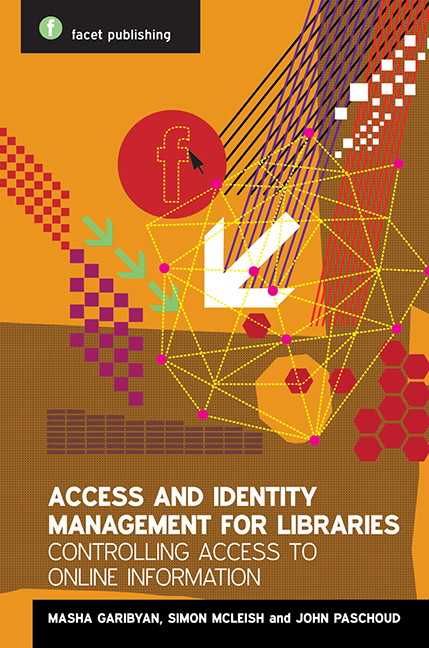Book contents
- Frontmatter
- Contents
- Foreword
- Acknowledgements
- Note to readers
- Glossary
- 1 What is access management, and why do libraries do it?
- 2 Electronic resources: public and not so public
- 3 Principles and definitions of identity and access management
- 4 Current access management technologies
- 5 Authentication technologies
- 6 Authorization based on physical location: how does the internet know where I am?
- 7 Authorization based on user identity or affiliation with a library: who you are? Or what you do?
- 8 Federated access: history, current position and future developments
- 9 How to choose access management and identity management products and services
- 10 Internet access provided by (or in) libraries
- 11 Library statistics
- 12 The business case for libraries
- Afterword
- Appendix 1 Case studies
- Appendix 2 A White Paper on Authentication and Access Management Issues in Cross-organizational Use of Networked Information Resources
- Index
4 - Current access management technologies
Published online by Cambridge University Press: 10 September 2022
- Frontmatter
- Contents
- Foreword
- Acknowledgements
- Note to readers
- Glossary
- 1 What is access management, and why do libraries do it?
- 2 Electronic resources: public and not so public
- 3 Principles and definitions of identity and access management
- 4 Current access management technologies
- 5 Authentication technologies
- 6 Authorization based on physical location: how does the internet know where I am?
- 7 Authorization based on user identity or affiliation with a library: who you are? Or what you do?
- 8 Federated access: history, current position and future developments
- 9 How to choose access management and identity management products and services
- 10 Internet access provided by (or in) libraries
- 11 Library statistics
- 12 The business case for libraries
- Afterword
- Appendix 1 Case studies
- Appendix 2 A White Paper on Authentication and Access Management Issues in Cross-organizational Use of Networked Information Resources
- Index
Summary
This chapter gives an overview of some current access management technologies and the advantages and disadvantages of using a particular technology.
In this chapter, we give a brief introduction to material which will be covered in more detail in Chapters 6–9 of the book, in order to give an overview of the various ways in which access management can be carried out for electronic resources. Relevant references will be given in the more detailed discussions of each of these mechanisms later on.
IP address
The simplest and least sophisticated form of online access management relies on information which is part of every internet access: the IP address. Its basic nature is indicated by the name, as ‘IP’ is short for ‘internet protocol’, one of the most important of the fundamental building blocks of the internet. An IP address is a sequence of numbers which is used to identify the source or target of a communication online; domain names such as www.google.com can be ‘resolved’ into IP addresses so that they can be found and accessed, and an internet service provider (ISP) will assign a computer an IP address when it arranges internet access for it.
The assignment process relies on the ISP being registered as the manager of a group of IP addresses, and this fact makes it possible for the IP address to be used as an access management technology, it being a simple matter for a server to be configured to allow or block access to it from lists of IP addresses. A college or university will have such a group of IP addresses and, by arrangement with the publisher of a resource, can obtain access for users who access the internet from on-campus computer equipment. Figure 4.1 demonstrates the process of IP address authentication.
While easy to set up, access control by IP address is lacking in the flexibility needed for the modern environment. While being a nice, easy solution for access from on campus, requiring little administration and no work from users once they are logged on to the campus network, it does not allow access from home users, or any means by which specific users or groups of users can be identified, thus barring the use of such services as personalization or access control at a more granular level than just ‘in’ or ‘out’.
- Type
- Chapter
- Information
- Access and Identity Management for LibrariesControlling Access to Online Information, pp. 31 - 38Publisher: FacetPrint publication year: 2014



